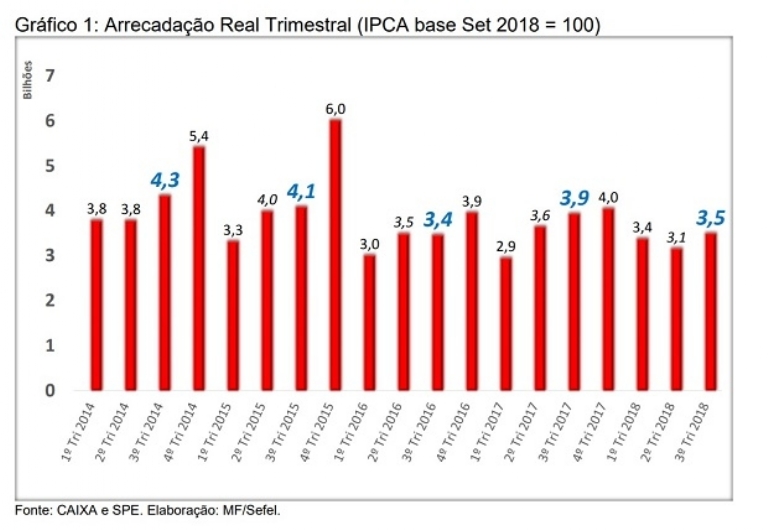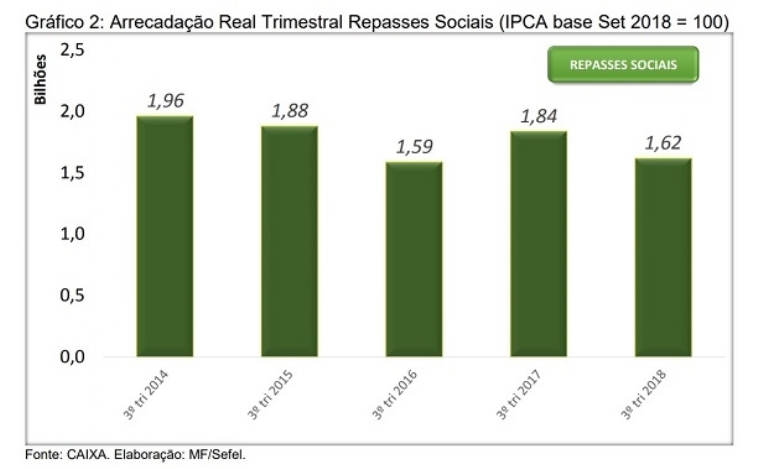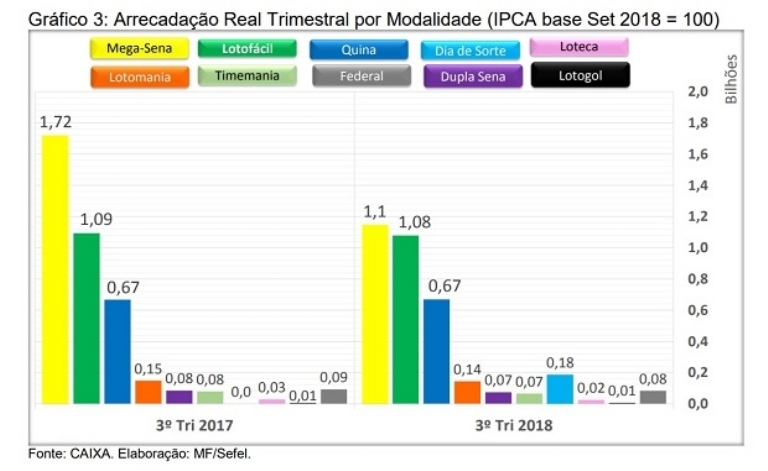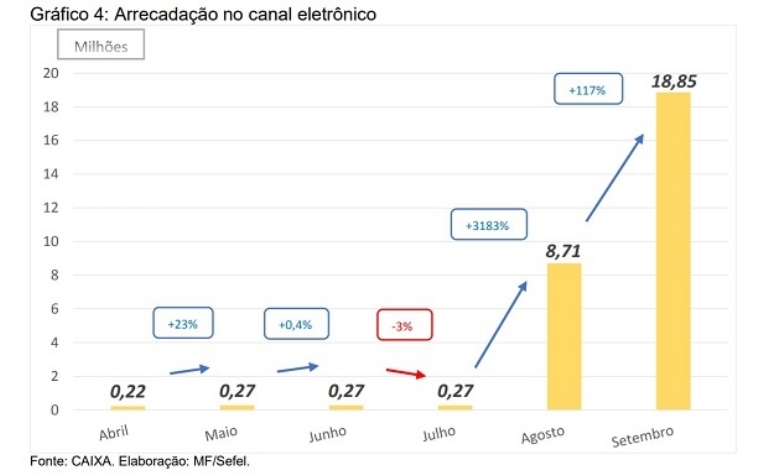

In this third edition, in order to update the readers about the main facts that occurred in the last six months in the Brazilian regulation of lotteries, the publication also includes some considerations about the provisional measure consolidating the distribution of lottery resources and the LOTEX concession process, among other topics.
2. Overview of the Brazilian Lottery Market
2.1. Of the collections and real rate of growth
In Table 1, in a comparison of the third quarter of 2018 with the same period of the previous year, it is observed that the collection of federal lotteries decreased from R$ 3.74 billion (US$ 1bn) in the third quarter of 2017 to R$ 3.47 billion (US$ 930m) in the third quarter of 2018, a 7% down in nominal terms. When comparing the gross domestic product (GDP), there was also a decrease, from 0.23% of GDP in the third quarter of 2017 to 0.20% of GDP in the same quarter in 2018.

In the chart below, in the comparison of the third quarter of 2017 with its equivalent in 2018, in real terms, the quarterly collection (IPCA base 2018 = 100) of the federal lotteries decreased by 11%, from R$ 3,91 billion (US$ 1.05bn) in 2017 to R$ 3.47 billion (US$ 935m) in 2018.
Observing the level of the last four years, when in the third quarter of 2014 the value of the collection was at R$ 4.32 billion (US$ 1.16bn), it is estimated a decrease of approximately 20% in real terms in that period.

With the decrease of the collection in the third quarter of 2018 in relation to the same period of the previous year, there was less transfer of resources from the lotteries to the social programs, as well as the collection of the Income Tax with the award granted. In fact, in real terms, social transfers were down 12% between the third quarter of 2017 (R$ 1.84 billion – US$ 496m) and the third quarter of 2018 (R$ 1.62 billion – US$ 436m).

In Chart 3, the collection by lottery product is broken down and the third quarter of 2017 is compared with its equivalent in 2018. A substantial real decrease of Mega-Sena (-33%), the lottery product with the highest participation in the portfolio of CAIXA lotteries. In turn, it is observed the Dia de Sorte occupying the fourth place in collection, with less than six months of launching.

2.2. From the growth of the electronic channel
On August 10, 2018, CAIXA launched a website so that anyone, over 18 years old, whether or not the bank's client, can place bets online in any lottery product. To date, this possibility was only available to CAIXA customers and to Mega-Sena bets.
The only modality that was left out of this release is the federal lottery (passive mode). At first, the difficulty in making the federal lottery available for online betting is that in this case the bettor buys a physical ticket, and does not choose numbers, as in other lottery modes.
The launch of lotteries on the internet brought great expectations regarding the increase in the number of lottery bets, especially for Mega da Virada, a flagship game. Initially, CAIXA expects an increase of approximately 3% in the collection, which will generate an increase of approximately R$ 450 million (US$ 121m) per year, mainly coming from a younger audience, accustomed to making purchases and banking services over the internet. Figure 4 illustrates the recent growth in the collection by the electronic channel made available by CAIXA.

As can be seen from figure 4, there is a tendency to increase this marketing channel. In fact, in April 2018, there was a commercialization via electronic channel around R$ 272,000 (US$ 73,347); and now, in September of the same year, jumped to more than R$ 18 million (US$ 4.85m). However, it is prudent to expect a slightly longer series for more robust conclusions.
4. Considerations regarding MPV 841/2018 and MPV 846/2018
Provisional Measure No. 841 of June 11, 2018 and No. 846 of July 31, 2018, together constitute a historical demand of the national lottery sector, which even had before that MPV a legal framework of confusing and distracted resources distribution in fifteen legal regulations.
These MPV were designed to give clarity and transparency to the distribution of lottery revenues through the consolidation and unification of the laws that distribute the resources originated in lotteries.
In order to understand why the resulting greater transparency and modernization in the distribution of lottery revenues, it is worth mentioning that this revenue can be divided into three parts: (i) operator remuneration; ii) portion that returns to the bettor in the form of payout; iii) allocation to social beneficiaries. The sum of these shares is equal to the total collected from the bets, which, by definition, must correspond to 100%.
However, before these MPVs, eight of the ten existing lottery products totaled their collections in nominal values ranging from 104.5% to 115%. This situation arose from the fact that the legislation distributing lottery resources was scattered in fifteen legal regulations, which hindered or obscured the understanding that the sum of the parties should equal 100%.
Graph 3 describes the 10 currently marketed lottery products.
In fact, the expan sion of legislation on the distribution of lottery resources contributed to the fact that the parties accounted for more than 100%, both because it made it difficult to check these 100% and because there was no clarity in the understanding that, when seeking resources for a sector from lottery revenues, the payout or the withdrawal of the resources of the operator or of the social beneficiaries would necessarily be diminished.
By unifying the legislation, said MPV heals this difficulty of understanding, since it establishes the basis of calculation of all lotteries from the total of 100% of the effectively collected. In addition, it is understood that, after being converted into Law, there will be greater difficulty to change the payout, because there will be clarity to the fact that, when reducing the payout, everyone loses.
In addition, if they wish to increase the amount distributed to a particular social beneficiary, they will have to withdraw from another beneficiary through a legitimate discussion of resources within the National Congress, such as will occur in the process of MPV nº 846. In other words, it will be a transparent discussion by resources, which will result in accountability of revenues from lotteries.
5. Considerations Concerning the Lotex Auction
The Fiscal, Energy and Lottery Follow-up Secretariat, in a continuous effort of interaction and transparency with the society, met with BNDES, PPI and lottery companies, in order to find out why the LOTEX auction did not receive a proposal on June 25, 2018, the day established by the bidding schedule
Following these individualized meetings with the companies in the sector, Sefel, together with the BNDES and PPI, opted to amend the bidding document and the LOTEX concession contract, in order to align them with the new scenario presented by the alleged bidders. After announcing these changes to the technicians of the Court of Auditors of the Union, public notice no. 3/2018 - PPI / PND was issued for LOTEX concession, whose auction is scheduled for November 29, 2018.
Source: GMB